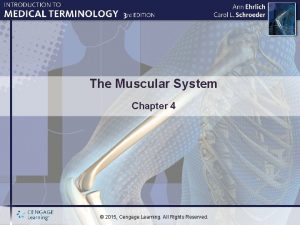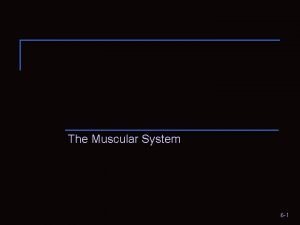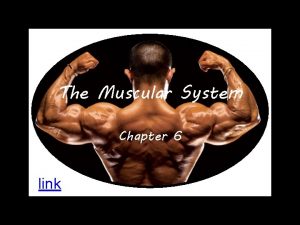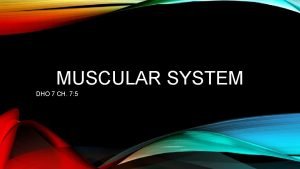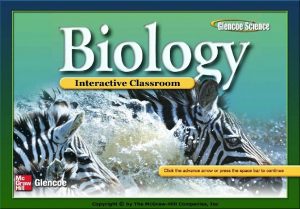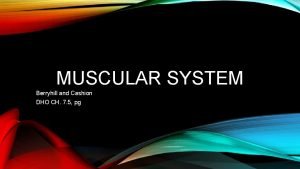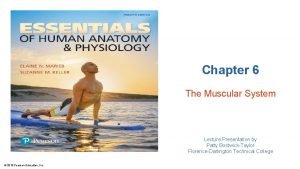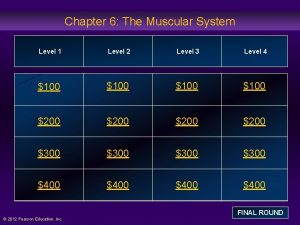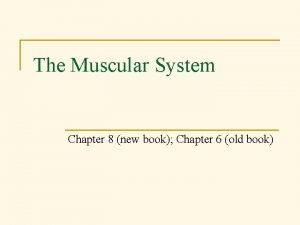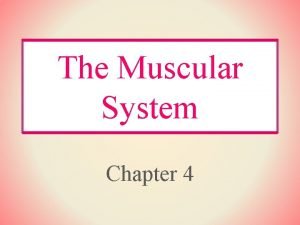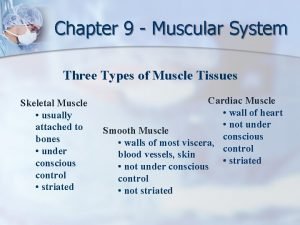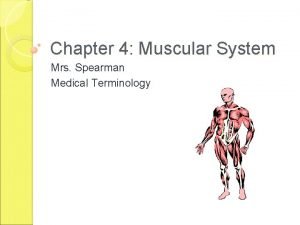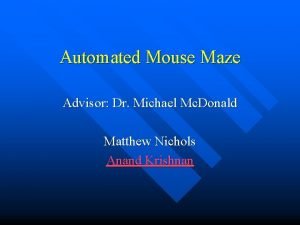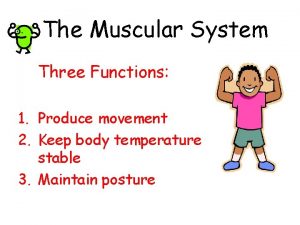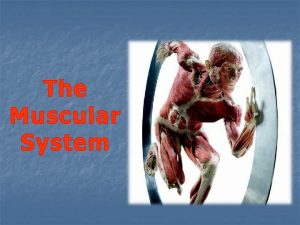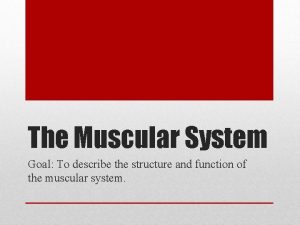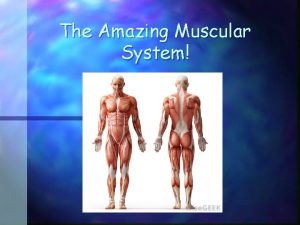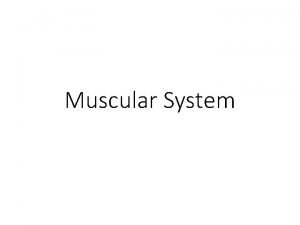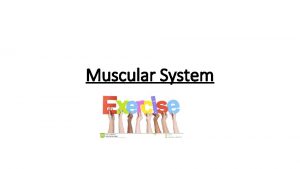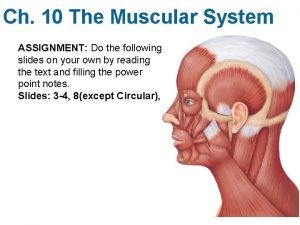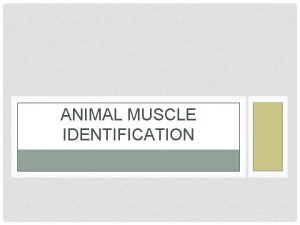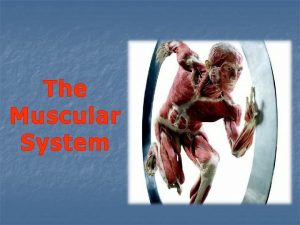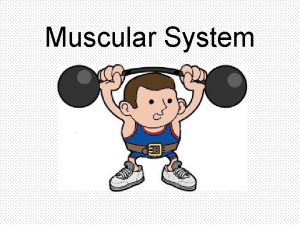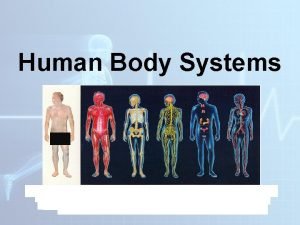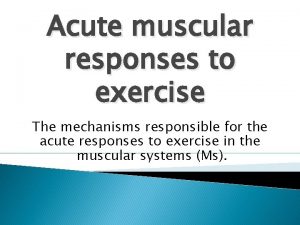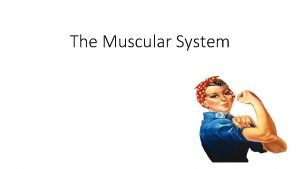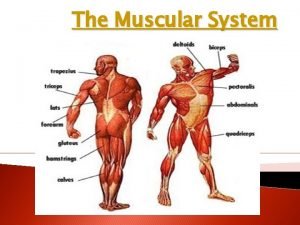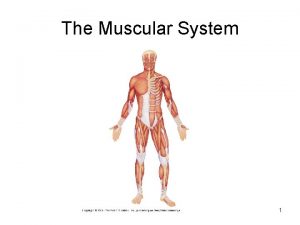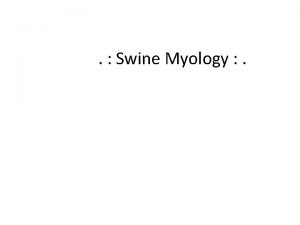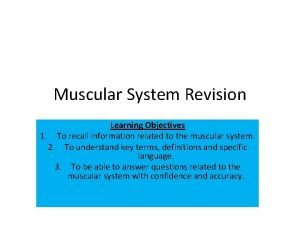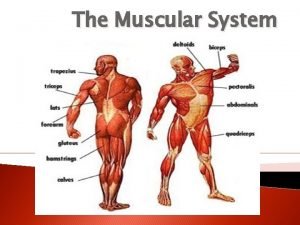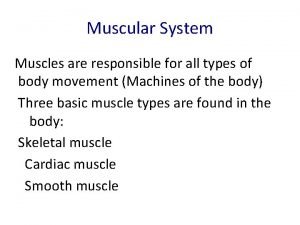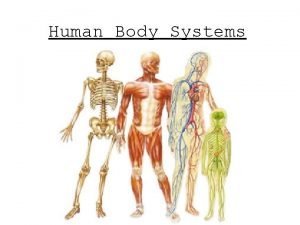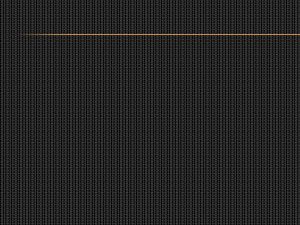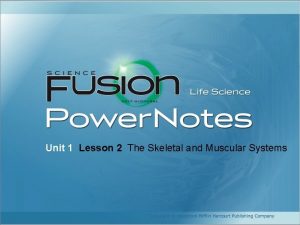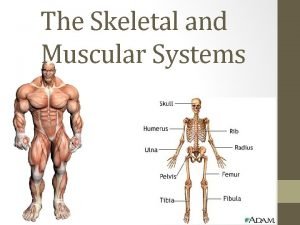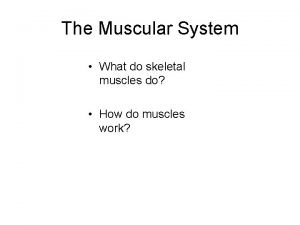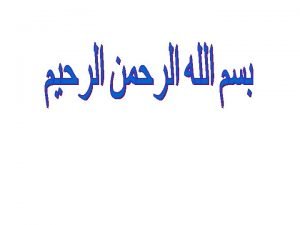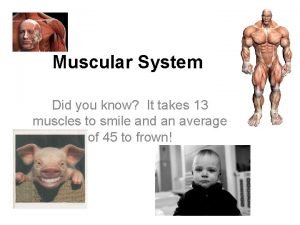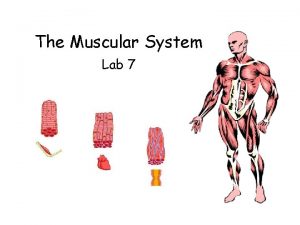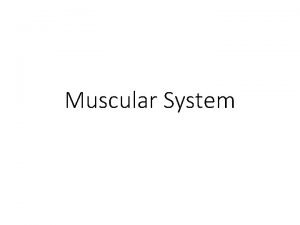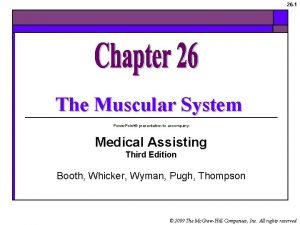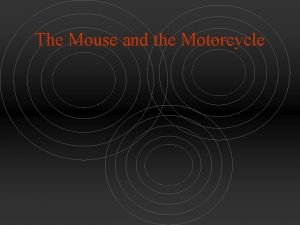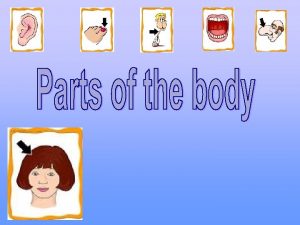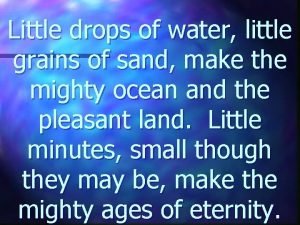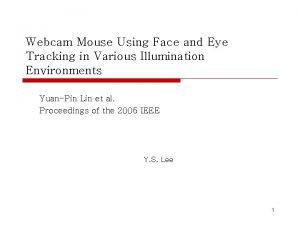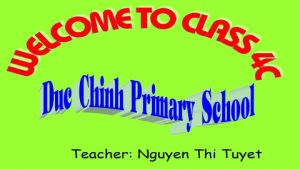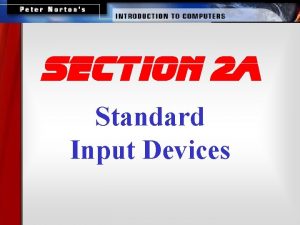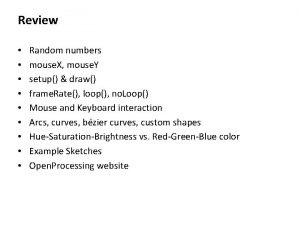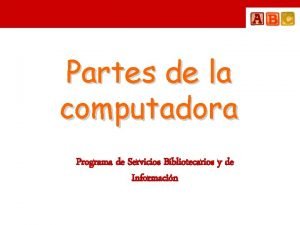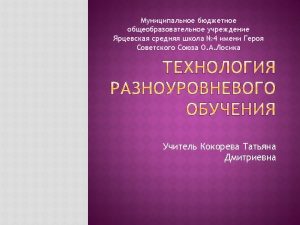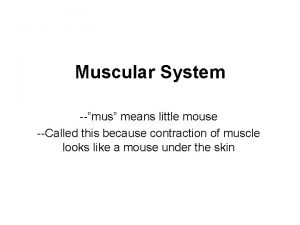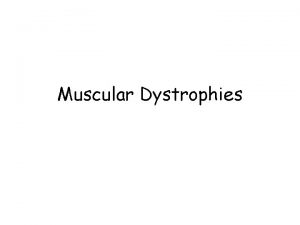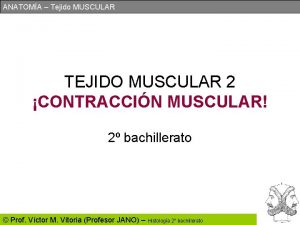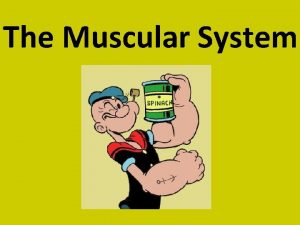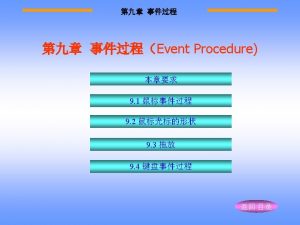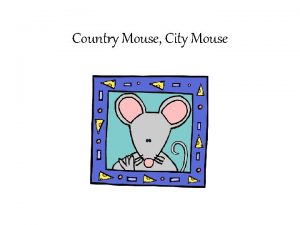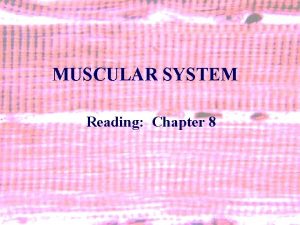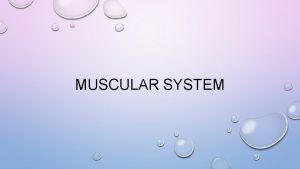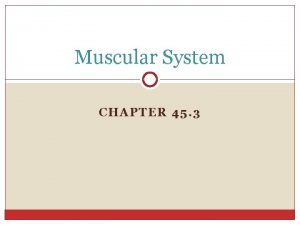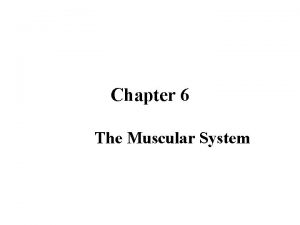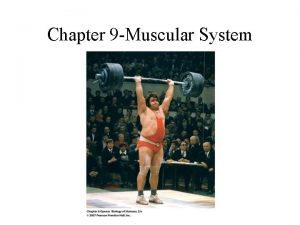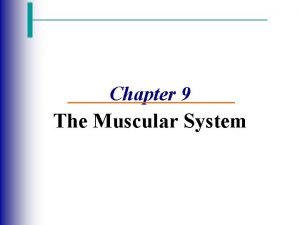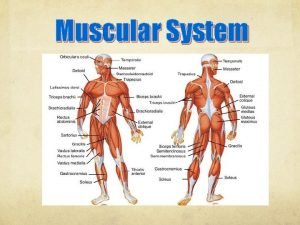Chapter 6 Muscular System 6 1 little mouse
















































































- Slides: 80

Chapter 6 Muscular System 6 - 1

little mouse Muscle comes from the Latin word mus, meaning little mouse. n In 1995, while examining a cadaver’s skull, two DENTISTS discovered a new muscle n During the summer and fall in the 1940’s and early 1950/s thousands of children in the US developed a viral infection that entered the spinal cord resulting in muscular paralysis. The common name of this viral infection is POLIO n 6 - 2

MUSCULAR DYSTROPHY: muscular disorder caused by the failure of a gene to code for a particular protein found in skeletal muscle n DUCHENNE dystrophy is the most severe type of MD and occurs only in males n The longest muscle in the human body isthe SATORIUS. 6 - 3 n

STEROID USE GERMANY is the county where steroid use began n It began in or to create or fashion what was called the SUPER RACE n The leader associated with this development was Hitler n ANABOLIC steroids were created for medical purposes n 6 - 4

n It is estimated that 1 out of every 10 young men has tried steroids, and the practice is spreading rapidly among young women. 6 - 5

Copyright The Mc. Graw-Hill Companies, Inc. Permission required for reproduction or display. Introduction: A. All movements require muscle which are organs using chemical energy to contract. B. The three types of muscle in the body are skeletal, smooth, and cardiac muscle. C. This chapter focuses on skeletal muscle. 6 - 6

Copyright The Mc. Graw-Hill Companies, Inc. Permission required for reproduction or display. Structure of a Skeletal Muscle A. Each muscle is an organ, comprised of skeletal muscle tissue, connective tissues, nervous tissue, and blood. 6 - 7

Copyright The Mc. Graw-Hill Companies, Inc. Permission required for reproduction or display. B. Connective Tissue Coverings A. 1. Layers of dense connective tissue, called fascia, surround and separate each muscle. 2. This connective tissue extends beyond the ends of the muscle and gives rise to tendons that are fused to the periosteum of bones. 6 - 8

Copyright The Mc. Graw-Hill Companies, Inc. Permission required for reproduction or display. 3. Sometimes coverings of adjacent muscles are connected to each other by broad fibrous sheets of connective tissue called aponeuroses. 4. The layer of connective tissue around each whole muscle is the epimysium; the perimysium surrounds individual bundles (fascicles) within each muscle; and each muscle cell (fiber) is covered by a connective tissue layer called endomysium. 6 - 9

Copyright The Mc. Graw-Hill Companies, Inc. Permission required for reproduction or display. 6 - 10

Copyright The Mc. Graw-Hill Companies, Inc. Permission required for reproduction or display. Study Analogy Pretend you are going to play a joke on someone and give them 100 pencils. The pencils will represent muscle fibers. First you wrap each individual pencil in tissue paper (dense tissue paperof course!). This would be endomysium. Then you take about 10 pencils in a bundle (a fascicle) and wrap them in paper (perimysium). After that you take all the bundles and wrap them in gift wrap (epimysium). But you are going to mail this joke, so you also have to wrap it in brown paper representing the fascia. 6 - 11

Copyright The Mc. Graw-Hill Companies, Inc. Permission required for reproduction or display. C. Skeletal Muscle Fibers 1. Each muscle fiber is a single, long, cylindrical muscle cell. 2. Beneath the sarcolemma (cell membrane/best described as a unit within a myofibrill) lies sarcoplasm (cytoplasm) with many mitochondria and nuclei; the sarcoplasm contains myofibrils. 6 - 12

Copyright The Mc. Graw-Hill Companies, Inc. Permission required for reproduction or display. a. b. c. d. 6 - 13 Thick filaments of myofibrils are made up of the protein myosin. Thin filaments of myofibrils are made up of the protein actin. The organization of these filaments produces striations. The enzyme ATPase occurs in the globular portion of myosin molecules.

Copyright The Mc. Graw-Hill Companies, Inc. Permission required for reproduction or display. 3. 6 - 14 A sarcomere extends from Z line to Z line. a. I bands (light bands) made up of actin filaments are anchored to Z lines. b. A bands (dark bands) are made up of overlapping thick and thin filaments. c. In the center of A bands is an H zone, consisting of myosin filaments only.

Copyright The Mc. Graw-Hill Companies, Inc. Permission required for reproduction or display. 6 - 15

Copyright The Mc. Graw-Hill Companies, Inc. Permission required for reproduction or display. 4. 6 - 16 Beneath the sarcolemma of a muscle fiber lies the sarcoplasmic reticulum (endoplasmic reticulum), which is associated with transverse (T) tubules (invaginations of the sarcolemma).

Copyright The Mc. Graw-Hill Companies, Inc. Permission required for reproduction or display. a. b. 6 - 17 Each T tubule lies between two cisternae of the sarcoplasmic reticulum and is open to the outside of the muscle fiber. The sarcoplasmic reticulum and transverse tubules activate the muscle contraction mechanism when the fiber is stimulated. This serves as the mode of transportation for an impulse deep into the muscle fiber.

Copyright The Mc. Graw-Hill Companies, Inc. Permission required for reproduction or display. 6 - 18

Copyright The Mc. Graw-Hill Companies, Inc. Permission required for reproduction or display. D. Neuromuscular Junction 1. The site where the motor neuron and muscle fiber meet is the neuromuscular junction. a. The muscle fiber membrane forms a motor end plate in which the sarcolemma is tightly folded and where nuclei and mitochondria are abundant. b. The cytoplasm of the motor neuron contains numerous mitochondria and synaptic vesicles storing neurotransmitters. 6 - 19

Copyright The Mc. Graw-Hill Companies, Inc. Permission required for reproduction or display. E. Motor Units 1. A motor neuron and the several muscle fibers it controls make up a motor unit; when stimulated to do so, the muscle fibers of the motor unit contract all at once. 6 - 20

Copyright The Mc. Graw-Hill Companies, Inc. Permission required for reproduction or display. 6 - 21

Copyright The Mc. Graw-Hill Companies, Inc. Permission required for reproduction or display. Skeletal Muscle Contraction A. 6 - 22 Muscle contraction involves several components that result in the shortening of sarcomeres, and the pulling of the muscle against its attachments.

Copyright The Mc. Graw-Hill Companies, Inc. Permission required for reproduction or display. B. Role of Myosin and Actin 1. Myosin consists of two twisted strands with globular cross-bridges projected outward along the strands. 2. Actin is a globular protein with myosin binding sites; tropomysosin and troponin are two proteins associated with the surface of the actin filaments. 6 - 23

Copyright The Mc. Graw-Hill Companies, Inc. Permission required for reproduction or display. 3. According to the sliding filament theory of muscle contraction, the myosin crossbridge attaches to the binding site on the actin filament and bends, pulling on the actin filament; it then releases and attaches to the next binding site on the actin, pulling again. 4. Energy from the conversion of ATP to ADP is provided to the cross-bridges from the enzyme ATPase, causing them to be in a “cocked” position. The ADP molecul; es on the surface of the actin serve as the active site for the crossbridge to form with molecules of myosin. 6 - 24

Copyright The Mc. Graw-Hill Companies, Inc. Permission required for reproduction or display. C. Stimulus for Contraction 1. The motor neuron must release the neurotransmitter acetylcholine from its synaptic vesicles into the synaptic cleft in order to initiate a muscle contraction. 2. Protein receptors in the motor end plate detect the neurotransmitters, and a muscle impulse spreads over the surface of the sarcolemma and into the T tubules, where it reaches the sarcoplasmic reticulum. 6 - 25

Copyright The Mc. Graw-Hill Companies, Inc. Permission required for reproduction or display. 3. 4. 6 - 26 Upon receipt of the muscle impulse, the sarcoplasmic reticulum releases its stored calcium to the sarcoplasm of the muscle fiber. The high concentration of calcium in the sarcoplasm interacts with the troponin and tropomyosin molecules, which move aside, exposing the myosin binding sites on the actin filaments.

Copyright The Mc. Graw-Hill Companies, Inc. Permission required for reproduction or display. 5. 6. 7. 6 - 27 Myosin cross-bridges now bind and pull on the actin filaments, causing the sarcomeres to shorten. After the nervous impulse has been received, acetylcholinesterase rapidly decomposes the acetylcholine. Then, calcium is returned to the sarcoplasmic reticulum, and the linkages between myosin and actin are broken.

Copyright The Mc. Graw-Hill Companies, Inc. Permission required for reproduction or display. 6 - 28

Copyright The Mc. Graw-Hill Companies, Inc. Permission required for reproduction or display. Study Analogy: Think of a very familiar love story. The actin and myosin are in love and would love to bind (keep it clean, think kiss). However, the actin is being guarded by the troponin and tropomysin (T-T complex), perhaps they are her parents or guardians? But someone is looking out for the love birds, maybe a fairy godmother? They send a messenger in the form of a nerve impulse. This messenger isn’t someone allowed in the house, so they send a second messenger (acetylocholinesterase) by way of the trusty Ttubules. This messenger releases a distractor (aka calcium). Pretend this is a belly dancer or someone from Publisher’s clearing house or 6 - 29 some other such distraction.

Copyright The Mc. Graw-Hill Companies, Inc. Permission required for reproduction or display. While the T-T complex is so occupied, actin and myosin are free to bind. Of course this takes a lot of energy (who said love was easy? ) But the messenger has only been paid for so long (destroyed by acetylcholinesterase) and the distractor can only dance (or whatever) for so long and has to leave. (calcium returns to sarcoplasmic reticulum). Thus the linkages are broken and they cannot live happily every after. But wait, another impulse may come along at any time! 6 - 30

Copyright The Mc. Graw-Hill Companies, Inc. Permission required for reproduction or display. D. 6 - 31 Energy Sources for Contraction 1. Energy for contraction comes from molecules of ATP. This chemical is in limited supply and so must often be regenerated 2. Creatine phosphate, which stores excess energy released by the mitochondria, is present to regenerate ATP from ADP and phosphate.

Copyright The Mc. Graw-Hill Companies, Inc. Permission required for reproduction or display. 3. Whenever the supply of ATP is sufficient, creatine phosphokinase promotes the synthesis of creatine phosphate. 4. As ATP decomposes, the energy from creatine phosphate can be transferred to ADP molecules, converting them back to ATP. 5. Rigor mortis that occurs un skeletal muscles a few hours after death is due to the lack of ATP, preventing muscle relaxation. 6 - 32

Copyright The Mc. Graw-Hill Companies, Inc. Permission required for reproduction or display. has E. Oxygen Supply and Cellular Respiration 1. The early phase of cellular respiration yields few molecules of ATP, so muscle oxygen, which enables the complete of breakdown mitochondria. 2. Hemoglobin in red blood cells carries oxygen to muscle. 3. The pigment myoglobin is responsible for the reddish brown color of skeletal muscles and stores oxygen in muscle tissue. 6 - 33

Copyright The Mc. Graw-Hill Companies, Inc. Permission required for reproduction or display. F. Oxygen Debt 1. The amount of oxygen needed to support the conversion of lactic acid to glucose in known as Oxygen Debt. During rest or moderate activity, there is enough oxygen to support aerobic respiration. During anaerobic respiration, glucose molecules are converted into molecules of pyruvic acid. 2. Oxygen deficiency may develop during strenuous exercise, and lactic acid accumulates as an end product of anaerobic respiration. a. Lactic acid diffuses out of muscle cells and is carried in the 6 - 34 bloodstream to the liver.

Copyright The Mc. Graw-Hill Companies, Inc. Permission required for reproduction or display. 3. 4. 6 - 35 Oxygen debt refers to the amount of oxygen that liver cells require to convert the accumulated lactic acid into glucose, plus the amount that muscle cells need to resynthesize ATP and creatine phosphate to their original concentrations. Repaying oxygen debt may take several hours.

Copyright The Mc. Graw-Hill Companies, Inc. Permission required for reproduction or display. G. Muscle Fatigue 1. When a muscle loses its ability to contract during strenuous exercise, it is referred to as fatigue. 2. Muscle fatigue usually arises from the accumulation of lactic acid in the muscle. a. A lowered p. H as a result of accumulated lactic acid prevents the muscle from contracting. 6 - 36

Copyright The Mc. Graw-Hill Companies, Inc. Permission required for reproduction or display. 3. 6 - 37 A muscle cramp occurs due to a lack of ATP required to return calcium ions back to the sarcoplasmic reticulum so muscle fibers can relax.

Copyright The Mc. Graw-Hill Companies, Inc. Permission required for reproduction or display. H. Heat Production 1. Contraction of skeletal muscle represents an important source of heat for the body. 2. Much of the energy produced through the reactions of cellular respiration is lost as heat (another source of heat for the body). 6 - 38

Copyright The Mc. Graw-Hill Companies, Inc. Permission required for reproduction or display. Muscular Responses A. One method of studying muscle function is to remove a single fiber and connect it to a device that records its responses to electrical stimulation. B. Threshold Stimulus 1. A muscle fiber remains unresponsive to stimulation unless the stimulus is of a certain strength, called the threshold stimulus. The minimal stimulus needed to elicit a muscle contraction. 6 - 39

Copyright The Mc. Graw-Hill Companies, Inc. Permission required for reproduction or display. C. All-or-None Response 1. When a muscle fiber contracts, it contracts to its full extent (all-or-none response); it cannot contract partially. 6 - 40

Copyright The Mc. Graw-Hill Companies, Inc. Permission required for reproduction or display. D. Recording a Muscular Contraction 1. A myogram is the recording of an electrically-stimulated muscle contraction. 2. A single, short contraction involving only a few motor units is referred to as a twitch. 6 - 41

Copyright The Mc. Graw-Hill Companies, Inc. Permission required for reproduction or display. 3. 4. 6 - 42 The time delay between when the stimulus is applied and when the muscle contracts is called the latent period, which is less than 0. 01 second. The latent period is followed by a period of contraction and a period of relaxation.

Copyright The Mc. Graw-Hill Companies, Inc. Permission required for reproduction or display. E. Summation 1. A muscle fiber receiving a series of stimuli of increasing frequency reaches a point when it is unable to relax completely and the force of individual twitches combine by the process of summation. 2. If the sustained contraction lacks any relaxation, it is called a tetanic contraction. 6 - 43

Copyright The Mc. Graw-Hill Companies, Inc. Permission required for reproduction or display. F. Recruitment of Motor Units 1. An increase in the number of activated motor units within a muscle at higher intensities of stimulation is called recruitment. 6 - 44

Copyright The Mc. Graw-Hill Companies, Inc. Permission required for reproduction or display. G. Sustained Contractions 1. Summation and recruitment together can produce a sustained contraction of increasing strength. 2. Muscle tone is achieved by a continuous state of sustained contraction of motor units within a muscle. It is an example of a partial but sustained contraction. 6 - 45

Copyright The Mc. Graw-Hill Companies, Inc. Permission required for reproduction or display. A. Smooth Muscles Smooth Muscle Fibers 1. Smooth muscle cells are elongated with tapered ends, lack striations, and have a relatively undeveloped sarcoplasmic reticulum. 6 - 46

Copyright The Mc. Graw-Hill Companies, Inc. Permission required for reproduction or display. 2. Multiunit smooth muscle and visceral muscle are two types of smooth muscles. a. In multiunit smooth muscle, such as in the blood vessels and iris of the eye, fibers occur separately rather than as sheets. Tends not to display rhythmicity. 6 - 47

Copyright The Mc. Graw-Hill Companies, Inc. Permission required for reproduction or display. b. Visceral smooth muscle occurs in sheets and is found in the walls of hollow organs; these fibers can stimulate one another and display rhythmicity, and are thus responsible for peristalsis( The rhythmic, wavelike motion found in tubular visceral organs) in hollow organs and tubes. 6 - 48

Copyright The Mc. Graw-Hill Companies, Inc. Permission required for reproduction or display. B. Smooth Muscle Contraction 1. The myosin-binding-to-actin mechanism is the mostly same for smooth muscles and skeletal muscles. 2. Both acetylcholine and norepinephrine stimulate and inhibit smooth muscle contraction, depending on the target muscle. The botulinus toxin that causes botulism acts by preventing the release of ACETYLCHOLINE 6 - 49

Copyright The Mc. Graw-Hill Companies, Inc. Permission required for reproduction or display. 3. 4. 6 - 50 Hormones can also stimulate or inhibit contraction. Smooth muscle is slower to contract and relax than is skeletal muscle, but can contract longer using the same amount of ATP.

Copyright The Mc. Graw-Hill Companies, Inc. Permission required for reproduction or display. Cardiac Muscle A. B. 6 - 51 The mechanism of contraction in cardiac muscle is essentially the same as that for skeletal and smooth muscle, but with some differences. Cardiac muscle has transverse tubules that supply extra calcium, and can thus contract for longer periods.

Copyright The Mc. Graw-Hill Companies, Inc. Permission required for reproduction or display. C. D. 6 - 52 Complex membrane junctions, called intercalated disks, join cells and transmit the force of contraction from one cell to the next, as well as aid in the rapid transmission of impulses throughout the heart. Cardiac muscle is self-exciting and rhythmic, and the whole structure contracts as a unit.

Copyright The Mc. Graw-Hill Companies, Inc. Permission required for reproduction or display. Skeletal Muscle Actions A. Origin and Insertion 1. The immovable end of a muscle is the origin, while the movable end is the insertion; contraction pulls the insertion toward the origin. 2. Some muscles have more than one insertion or origin. 6 - 53

Copyright The Mc. Graw-Hill Companies, Inc. Permission required for reproduction or display. B. Interaction of Skeletal Muscles 1. Of a group of muscles, the one doing the majority of the work is the prime mover. 2. Helper muscles (assist the prime mover) are called synergists; opposing muscles are called antagonists. 3. The enlargement of muscle fibers as a result of physical exercise is called hypertrophy. 4. The reduction in capillary networks, mitochondria, and the size of actin and myosin silaments is called atrophy. 6 - 54

Copyright The Mc. Graw-Hill Companies, Inc. Permission required for reproduction or display. Major Skeletal Muscles A. 6 - 55 Muscles are named according to any of the following criteria: size, shape, location, action, number of attachments, or direction of its fibers.

Copyright The Mc. Graw-Hill Companies, Inc. Permission required for reproduction or display. B. Muscles of Facial Expression 1. Muscles of facial expression attach to underlying bones and overlying connective tissue of skin, and are responsible for the variety of facial expressions possible in the human face. 2. Major muscles include epicranius, orbicularis oculi, orbicularis oris, buccinator, zygomatigus, 6 - 56

Copyright The Mc. Graw-Hill Companies, Inc. Permission required for reproduction or display. 6 - 57

Copyright The Mc. Graw-Hill Companies, Inc. Permission required for reproduction or display. C. Muscles of Mastication 1. Chewing movements include up and down as well as side-to-side grinding motions of muscles attached to the skull and lower jaw. 2. Chewing muscles include masseter and temporalis. 6 - 58

Copyright The Mc. Graw-Hill Companies, Inc. Permission required for reproduction or display. D. Muscles that Move the Head 1. Paired muscles in the neck and back flex, extend, and turn the head. 2. Major muscles include sternocleidomastoid, splenius capitis, and semispinalis capitis. 6 - 59

Copyright The Mc. Graw-Hill Companies, Inc. Permission required for reproduction or display. E. Muscles that Move the Pectoral Girdle 1. The chest and shoulder muscles move the scapula. 2. Major muscles include trapezius, rhomboideus major, levator scapulae, serratus anterior, and pectoralis minor. 6 - 60

Copyright The Mc. Graw-Hill Companies, Inc. Permission required for reproduction or display. 6 - 61

Copyright The Mc. Graw-Hill Companies, Inc. Permission required for reproduction or display. F. Muscles that Move the Arm 1. Muscles connect the arm to the pectoral girdle, ribs, and vertebral column, making the arm freely movable. 2. Flexors include the coracobrachialis and pectoralis major. 6 - 62

Copyright The Mc. Graw-Hill Companies, Inc. Permission required for reproduction or display. 3. Extensors include the teres major and latissimus dorsi. 4. Abductors include the supraspinatus and the deltoid. 5. Rotators are the subscapularis, infraspinatus, and teres minor. 6 - 63

Copyright The Mc. Graw-Hill Companies, Inc. Permission required for reproduction or display. G. Muscles that Move the Forearm 1. These muscles arise from the humerus or pectoral girdle and connect to the ulna and radius. 2. Flexors are the biceps brachii, brachialis, and brachioradialis. 6 - 64

Copyright The Mc. Graw-Hill Companies, Inc. Permission required for reproduction or display. 6 - 65

Copyright The Mc. Graw-Hill Companies, Inc. Permission required for reproduction or display. 3. An extensor is the triceps brachii muscle. 4. Rotators include the supinator, pronator teres, and pronator quadratus. 6 - 66

Copyright The Mc. Graw-Hill Companies, Inc. Permission required for reproduction or display. H. Muscles that Move the Wrist, Hand, and Fingers 1. Movements of the hand are caused by muscles originating from the distal humerus, and the radius and ulna. 2. Flexors include the flexor carpi radialis, flexor carpi ulnaris, palmaris longus, and flexor digitorum profundus. 6 - 67

Copyright The Mc. Graw-Hill Companies, Inc. Permission required for reproduction or display. 3. Extensors include the extensor carpi radialis longus, extensor carpi radialis brevis, extensor carpi ulnaris, and extensor digitorum. 6 - 68

Copyright The Mc. Graw-Hill Companies, Inc. Permission required for reproduction or display. I. Muscles of the Abdominal Wall 1. This group of muscles connects the rib cage and vertebral column to the pelvic girdle. a. A band of tough connective tissue, the linea alba, extending from the xiphoid process to the symphysis pubis, serves as an attachment for certain abdominal wall muscles. 6 - 69

Copyright The Mc. Graw-Hill Companies, Inc. Permission required for reproduction or display. 2. 6 - 70 These four muscles include: external oblique, internal oblique, transverse abdominis, and rectus abdominis.

Copyright The Mc. Graw-Hill Companies, Inc. Permission required for reproduction or display. J. Muscles of the Pelvic Outlet 1. The superficial urogenital diaphragm fills the space within the pubic arch, and the deeper pelvic diaphragm forms the floor of the pelvic cavity. 2. Pelvic diaphragm ncludes the levator ani. 6 - 71

Copyright The Mc. Graw-Hill Companies, Inc. Permission required for reproduction or display. 3. Urogenital diaphragm: includes the superficial transversus, perinei, bulbospongiosus, and ischiocavernosus. 6 - 72

Copyright The Mc. Graw-Hill Companies, Inc. Permission required for reproduction or display. K. Muscles that Move the Thigh 1. The muscles that move thigh are attached to the femur and to the pelvic girdle. 2. Anterior group includes the psoas major and iliacus. 6 - 73

Copyright The Mc. Graw-Hill Companies, Inc. Permission required for reproduction or display. 6 - 74

Copyright The Mc. Graw-Hill Companies, Inc. Permission required for reproduction or display. 3. Posterior group is made up of the gluteus maximus, gluteus medius, gluteus minimus, and tensor fasciae latae. 4. Thigh adductors include the adductor longus, adductor magnus, and gracilis. 6 - 75

Copyright The Mc. Graw-Hill Companies, Inc. Permission required for reproduction or display. L. Muscles that Move the Leg 1. This group connects the tibia or fibula to the femur or pelvic girdle. 2. Flexors are the biceps femoris, semitendinosus, semimembranosus, and sartorius. 3. An extensor is the quadruceps femoris group made up of four parts: rectus femoris, vastus lateralis, vastus medialis, and vastus intermedius. The SARTORIUS is the longest muscle in the human body 6 - 76

Copyright The Mc. Graw-Hill Companies, Inc. Permission required for reproduction or display. 6 - 77

Copyright The Mc. Graw-Hill Companies, Inc. Permission required for reproduction or display. M. Muscles that Move the Ankle, Foot, and Toes 1. Muscles that move the foot are attached to the femur, fibula, or tibia, and move the foot upward, downward, or in a turning motion. 2. Dorsal flexors include the tibialis anterior, peroneus tertius, and extensor digitorum longus. 6 - 78

Copyright The Mc. Graw-Hill Companies, Inc. Permission required for reproduction or display. 6 - 79

Copyright The Mc. Graw-Hill Companies, Inc. Permission required for reproduction or display. 3. Plantar flexors are the gastrocnemius soleus, and flexor digitorum longus. 4. An invertor is the tibialis posterior. 5. An evertor is the peroneus longus. 6 - 80
 Little mouse, little mouse, where is your house
Little mouse, little mouse, where is your house Difference between strength and endurance
Difference between strength and endurance 1 little 2 little 3 little indians
1 little 2 little 3 little indians 1 little 2 little 3 little indian
1 little 2 little 3 little indian Hurry scurry little mouse
Hurry scurry little mouse Dorsiflexion word parts
Dorsiflexion word parts Unit 6:5 muscular system
Unit 6:5 muscular system The muscular system chapter 6
The muscular system chapter 6 Chapter 6 the muscular system figure 6-12
Chapter 6 the muscular system figure 6-12 Chapter 7:5 muscular system
Chapter 7:5 muscular system Chapter 9 muscular system
Chapter 9 muscular system Chapter 32 section 3 the muscular system
Chapter 32 section 3 the muscular system Contractile unit of muscle
Contractile unit of muscle Chapter 7:5 muscular system
Chapter 7:5 muscular system Chapter 6 the muscular system
Chapter 6 the muscular system Cengage chapter 4 answers
Cengage chapter 4 answers Chapter 6 the muscular system
Chapter 6 the muscular system Chapter 6 the muscular system
Chapter 6 the muscular system Muscles that have their fasciculi arranged like barbs
Muscles that have their fasciculi arranged like barbs Chapter 8 the muscular system
Chapter 8 the muscular system The muscular system chapter 4
The muscular system chapter 4 Chapter 9 muscular system
Chapter 9 muscular system Define myocele
Define myocele Multi-maze system for mouse / rat
Multi-maze system for mouse / rat What do muscles move
What do muscles move The rhomboid minor muscle sits __________.
The rhomboid minor muscle sits __________. Function of muscle
Function of muscle Amazing facts about the muscular system
Amazing facts about the muscular system Root word myo
Root word myo Muscular system label
Muscular system label Muscular system assignment
Muscular system assignment Brachiocephalicus
Brachiocephalicus Navigating the body regions of the body
Navigating the body regions of the body Muscular system primary function
Muscular system primary function Whats the muscular system
Whats the muscular system Sarcomore
Sarcomore Muscular system response to exercise
Muscular system response to exercise Whats the muscular system
Whats the muscular system Muscles of the body
Muscles of the body Muscular system
Muscular system Superficial muscular system
Superficial muscular system Hog anatomy
Hog anatomy Muscular system learning objectives
Muscular system learning objectives Muscular syst
Muscular syst Muscular system means
Muscular system means 3 function of muscular system
3 function of muscular system Musculo fusiforme
Musculo fusiforme Lesson 2 muscle storyboard
Lesson 2 muscle storyboard Muscular system
Muscular system Major skeletal muscles
Major skeletal muscles Named
Named Major muscles
Major muscles Muscle system diagram
Muscle system diagram Muscular system
Muscular system Whats the job of the muscular system
Whats the job of the muscular system Lab 7 the muscular system
Lab 7 the muscular system Muscular system root words
Muscular system root words Skeletal and muscular system
Skeletal and muscular system Muscular system
Muscular system The mouse and the motorcycle chapter questions
The mouse and the motorcycle chapter questions Two little hands two little feet poem
Two little hands two little feet poem Quantifier of fresh air
Quantifier of fresh air Little grains of sand make the mighty ocean
Little grains of sand make the mighty ocean Few a few ero
Few a few ero She is lucky she has few problems
She is lucky she has few problems Fill in a few a little
Fill in a few a little Complete the sentences use these words
Complete the sentences use these words Chapter 36 skeletal muscular and integumentary systems
Chapter 36 skeletal muscular and integumentary systems Chapter 14 lesson 3 the nervous system
Chapter 14 lesson 3 the nervous system Mouse control whitehouse
Mouse control whitehouse Webcam eye tracking mouse
Webcam eye tracking mouse Tipos de mouse
Tipos de mouse Little friends may prove great friends
Little friends may prove great friends Exposition rising action climax
Exposition rising action climax Space mouse classic
Space mouse classic The mice and the cat story writing
The mice and the cat story writing Standard input devices
Standard input devices Draw a mouse with numbers
Draw a mouse with numbers Learn.genetics.utah/content/addiction/mouse
Learn.genetics.utah/content/addiction/mouse Output mouse
Output mouse Palm os
Palm os





